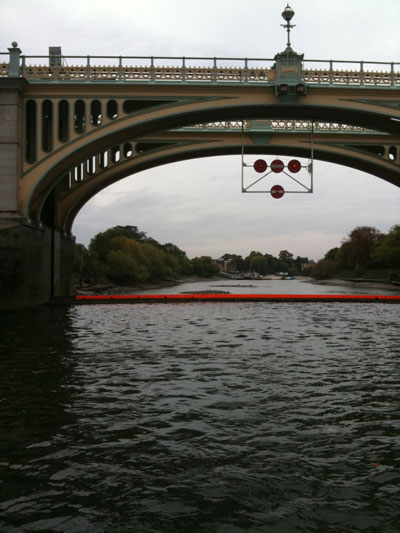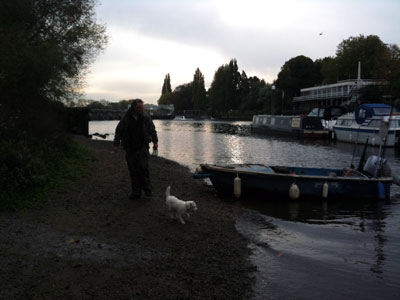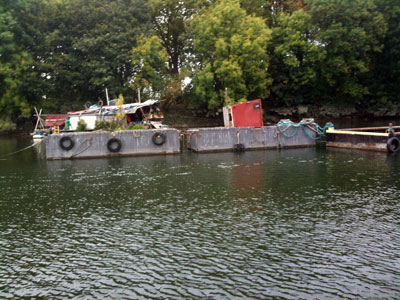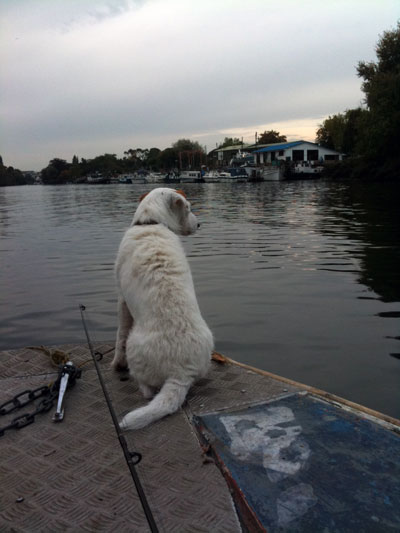The tidal River Thames stretches from Southend to Teddington. The section between Richmond half lock and Teddington is known locally as the Semi-tidal, the reason being that the water level between is controlled at Richmond, so making the section navigable for boats at all times. This in turn has a dramatic effect on the size of the twice daily tides. Depths at London Bridge can vary by 25ft whereas on the semi tidal it’s more like 7ft.A mere ripple compared with the maelstrom downstream. As a consequence fishing is easier, not only are there less changes in flow, but a monumental difference in silt. If you want silt in your coffee, sandwiches and everything else then head below Richmond, you won’t be disappointed.

Aesthetically some parts can resemble Prince Charles’ carbuncle; well, if you’ve got a houseboat you’ve got to have satellite TV, and unlike a house you can paint a houseboat any colour you like. By contrast, the best panoramas on this stretch are of picture postcard quality. There is even a palace at Richmond, upstream of the railway bridge, privately owned by a titled family. Opposite which are two islands, both used by Herons for nesting and both strictly out of bounds. We then pass another unpopulated island, Corp Island, surrounded by moored boats of all sizes and descriptions. We go under Richmond road bridge and pass a splendid hotel, The Petersham, and the Star and Garter home for disabled serviceman which dominate Richmond Hill, both with fantastic views of the river. Adjacent to the river at the bottom of the hill is Petersham Farm, demolished and completely rebuilt in the past year, separated from the river by the towpath.
Gazing out to the river we see another island, Glover Island, again unpopulated, covered in Willow Trees and Himalayan Balsam. This alien plant has taken over much of the banks on this section. Its scent and early flowering are a magnet to the bees, sadly depriving some of our native species of pollination, because of its long flowering period. While we’re on the subject of alien species, if you move your eyes from the horizontal to skyward you may well see our latest invader, the Green Parakeet. Rumour has it they were released from Shepperton studios after being used in a film. If you don’t see them just keep your ears open, they don’t half make a racket!
If you could see below the water then the infamous Chinese Mitten Crab would be apparent. It arrived in the ballast of ships back in the early nineteenth century and has spread from the docks in London to cover an enormous area. With specimens as big as your hand, they can be a nuisance. Particularly while they are on their migration to the estuary to reproduce, or on their return journey. Regular anglers who are unfortunate enough to catch one, put their size twelves on them, whilst non-native anglers have a habit of putting them in a plastic bag and then in their rucksack.
Why is it alien species are either, noisy, destructive or just plain ugly? Maybe Darwin could supply the answer.

Opposite Glover Island is a free public slipway in River Lane, with free parking. Shush! Don’t tell everyone!
After Glover Island we encounter the Hermit. Yes, you read correctly, a modern twenty-first century Hermit. Admittedly he doesn’t live in a cave, but if you look at his ramshackle collection of oil drums, scaffolding, wood and plastic floating on the river, it is definitely cave shaped. Equipped with a wood burning stove and solar panels, it certainly is a one-off. The man himself is rarely seen and even less often spoken to. Occasionally he can be glimpsed gathering drift wood or adding to his collection of broken boats, canoes, and anything else that may drift by. For company he has a varied assortment of waterfowl that inhabit the motley collection of floating debris he has tethered around him. A scruffy dog can be seen but never heard, and very occasionally a female companion can sometimes be seen; would she be called a Hermitess ?
Travelling upstream on the opposite side is Twickenham, and Marble Hill House, a Paladin villa built around 1720. It’s a very substantial white building set in parkland and used for conferences, meetings, etc, and then there is Hammerton’s Ferry. Established in 1909 and crossing from Twickenham to Ham. Available in the summer from 10 till 6, seven days a week with a fare of one pound each way. Sadly no fishing boats are for hire, but row boats are. Why not hire one and check out the river for yourself?

Continuing upstream it isn’t long before Ham House looms large. One of the finest examples of an original Tudor home in the country, and built in 1610. (The straw mattress beds are pants, I once tried one when I was a youngster).
Next it’s another slipway. Ham Street car park, free parking again. This slipway used to be unobstructed but unfortunately you cannot launch a boat on a trailer due to the supposedly moveable posts being immovable.
Moving on we reach Eel Pie Island, so named for obvious reasons, with boatyards and residences. The punts moored on the Twickenham side belong to Francis Francis Punt club, a club that’s been going for 150 years and named after a famous Thames angler. It has an open membership and for fifty quid a year, you get to go out every weekend during the season, that’s got to be as cheap as pellets.
On leaving Eel Pie Island we see Radnor Gardens. Its name is a reference to a substantial 17th century house that was destroyed during the second world war. Once an excellent place to fish but sadly ruined by the beer and bivvy brigade. The upstream end of the gardens has a boatyard separated from the bank by a shallow channel. On the opposite side of the river we have Thames Young Mariners, a lake adjoined to the Thames by a working lock. No fishing is allowed.
From now on, till we reach Teddington, its all flash flats, sorry, apartments, on the Twickenham side and a nature reserve on the other. However the nature reserve nearly became a flood basin, but for three pairs of Song Thrushes.
That’s it; we’ve arrived at the end of the tour, it’s either go through one of the two locks, or jump the weir.
Perhaps, before we move on to the fish stocks, a word or two about the river itself. It has mainly a smooth, gravelly bottom, with deep silt beds in some slacks. Average depth is nine or ten feet at low water, although some areas are only two thirds of this, with the odd spot of thirteen feet. There are a few holes and gullies with most being in the weir itself, where depths can reach twenty feet or more [blame the German bombers for the holes].
Once a year in November, for about three weeks, this stretch is allowed to drop to its natural level, this is to allow for maintenance to lock gates, weirs, etc, etc. The loss of water makes it nearly unnavigable for boats and forces the fish to congregate in deeper water. Hence the combat Perch fishing at Teddington.
Fish-wise, the semi tidal is a real all-rounders heaven. Early season tides can bring occasional schools of mullet grazing (I wish I could catch one) and even baby bass and flatties can be seen on the gravels at Teddington.

If predators are your thing, then this should interest you; perch to nearly 5 lbs, zander to nearly 14lbs and pike to 34lbs (Bill Rushmer’s record). Although these fish have in recent years become highly targeted, if you get it right, you have a realistic chance of a 4lb perch, a double figure zander and maybe a 20lb pike. I say maybe because a buddy and I compared results over the last few seasons and agreed, one pike in about a hundred is a twenty. Nevertheless any of these fish are a terrific river catch.
For the carpers, they go to mid thirties, and if you caught one of those you would be up there with Terry Hearn’s dad! More realistic is a high twenty, with a double figure grassy a real possibility too. Usual tactics and features are the ticket, while pre-baiting can definitely bring rewards. Most importantly, don’t forget to think about abrasion resistance and boats catching your line.
Chub are less prevalent than upstream on the non tidal, and certainly smaller; a 5lber would be a real specimen. Barbel are present, supposedly to 19lbs (ask Bill Rushmer) and are nomadic, although pre-baiting carpers are known to have landed them to around 13lbs.
Bream are aplenty to an average of 6 or 7 pounds with bagfuls of 6oz dace on the stick in late summer, and, who knows, there are the odd 2lb roach too.
Mini species are present as well, although not as many as in years gone by – the river is too clean. If you’re lucky, ruff, gudgeon and bullhead may pull your string. The odd exotic can also sometimes turn up. Koi carp are not unknown as well as the very rare tench, and that’s the point and that’s the appeal.
You just never know what’s going to turn up. A regatta, an Indian funeral, a flood, or a drought. Perhaps an egret will wade the shore, a seal will entertain the twitchers, or a pair of llamas will stroll by with their handler. Or more likely, I’ll stop by to say hello and congratulate you on choosing the finest venue in the land.
A. Mushroom














